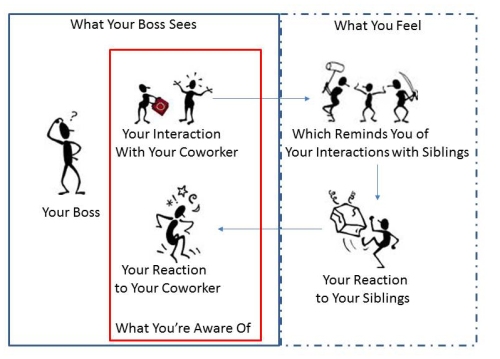Basics/Needs/Wants
My first exposure to the idea of how my needs impacted my career came from Laura Berman Fortgang’s book, Take Yourself to the Top. Fortgang divides things into basics/needs/wants. Most of us can tell what the basics are–enough food, housing, warmth, safety. Most of us also can tell the “wants”–house at the beach, Thunder season tickets, designer wardrobe, fill-in-the-blanks. It gets tricky when we are dealing with needs. Needs are sometimes disguised wants, but more often, they are buried in our subconscious–we don’t even recognize them when they are running our lives.
Examples
The kind of needs I’m talking about are those that start in early childhood–usually because of deprivation or mistreatment–and drive our behavior for the rest of our lives. Someone very close to me grew up incredibly poor and without things that practically everyone has–things like soap, combs, jelly, sufficient clothes, or coats. Her need was to never feel deprived again. She accumulated stuff to prevent the feeling of deprivation. It drove her whole life.
Some have the need to be appreciated. Some have the need to be respected. Some have the need to be treated fairly. Some need to be right. You get the idea. These needs are all wrapped up in our self-worth. If you don’t respect me, then you have shaken the very foundations of my belief in myself. When this happens at work, then you are behaving like the same five-year-old who initially developed this need. You probably aren’t aware that you are acting like a five-year-old. You probably feel completely righteous in your reaction. You won’t stop talking about it. You tell your co-workers how wronged you are, and they probably are somewhat intimidated by your level of emotion. They may or may not agree with you, but they are reluctant to challenge you because of how you are coming across about it.
This happens all the time. It happens to pretty much everyone. The way you can recognize it is by how upset you are. How driven you are to fix it. How much you talk about it. How much you think about it. These needs are legitimate. You came by them legitimately. My friend who was so deprived in her childhood was trying to protect herself from ever feeling that horrible again. But you need to get your needs out of your work. They will do much more damage than it is worth. People will think you’re completely irrational about weird stuff. They will not be able to connect the dots between your behavior that they see and your need that you are trying to address and whatever happened to you that created that need.
What Do You Do?
So, what do you do? Think back. Think of times when even you could tell you were being irrational. What was driving it? Are there patterns? Same reaction to similar situations? Same reaction to similar people? Figure out which needs are driving you (literally) crazy. Try to reason with yourself (this isn’t usually all that successful). Point out to yourself that that was then (when you were 5) and this is now (when you are an adult who really shouldn’t care if your GenY employee isn’t respecting you as much as you think she should). If trying to talk yourself out of it doesn’t work, don’t give up, but there is a Plan B.
 When you feel yourself getting irrational (ok, not irrational–incredibly irritated), try to think of another way that you can get this need met OUTSIDE OF WORK. Where can you be respected that matters more? Church? Home? Professional group? Who appreciates you who matters more than people at work? Can’t you go tell someone else you were right without rubbing your peer’s face in it?
When you feel yourself getting irrational (ok, not irrational–incredibly irritated), try to think of another way that you can get this need met OUTSIDE OF WORK. Where can you be respected that matters more? Church? Home? Professional group? Who appreciates you who matters more than people at work? Can’t you go tell someone else you were right without rubbing your peer’s face in it?
Why Should You Go To That Much Trouble?
Because it really does have a negative impact on your career. When you are being driven by things that are outside your conscious awareness, then you aren’t really in control. When you aren’t in control, then you will do something that looks stupid to people who can make decisions about your future. So, get your needs away from your work.





